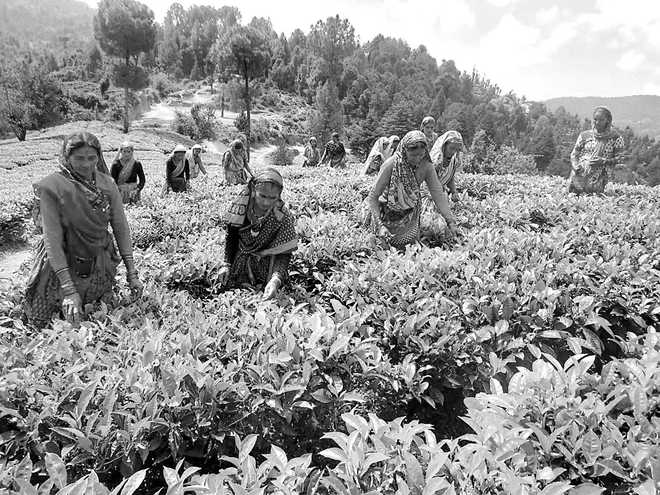
Tribune photo
Neena Sharma in Dehradun
ONCE a proud owner of British-planted tea gardens spanning over 10,000 hectares, Uttarakhand has seen concrete buildings, apathy among growers and falling tea prices shrink large swathes of lush green tea estates to 1,140 hectares. However, with the focus of the Union Budget (2018-2019) on promoting the organic farming, the hill state is keen on reviving the romance of “Uttarakhand tea” whose aroma and unquie flavour carved its own place among ardent supporters as far as in London in the distant past.
It was joint efforts of tea planters like Lyall, Dansey and Wheeler, who took upon the task of spreading the aroma of brew in the Garhwal and Kumaon divisions in 1836. The misty mountainous conditions added a unique flavour to the leaves plucked from the tea gardens of Chaukori and Berinag in Kumaon, set up by the English. Hooked to Chaukori and Berinag tea flavours, the English officers then went on to establish tea factories with machines for refining tea leaves. Today, what is left of that British legacy are four government-owned factories and a private-run, which produce 80,000 kg of tea annually, which is sold under the brand of name of “Uttarakhand tea”.
In a bid to revive tea plantation in the state, the department of horticulture has mapped out an ambitious plan to introduce tea farming in the hilly areas that are facing chronic problems of forced migration and disinterest in agriculture due to menace of wild animals. “In the hilly areas, there are places where farmers continue to use bio-manure, these areas would be tapped in to promote tea farming. The orthodox variety of tea, which is our popular flavour will flourish here due to conducive conditions,” says Subodh Uniyal, minister for horticulutre and agriculture.
Significantly, the Uttarakhand Tea Development Board has already gone organic in Ghorakhal (Nainital), Champawat and Nauti (Chamoli), bringing a total of 218 hectares under tea plantation. “We will give boost to organic tea plantation in the hilly areas as it is receiving a good response in the markets abroad due to heightened awareness about the merits of green tea,” says Uniyal.
Experts say the requirements for growing tea bushes like the PH value of soil in the range of 4.5 to 6, water-retaining quality of soil with temperature in the range of 10° C to 35°C and 150 cm of rainfall are easily met in the hilly areas.
“The soil wing at Bhawali has carried out a survey in 6,000 hectares of land and found it conducive. In the first phase, we will bring around 1,000 hectares of new areas under tea plantation in areas such as Chamoli, Tharali, Gairsain, Pokhri, Rudraprayag, Jakholi, Bageshwar, Gwaldam, Almora, Nainital and Champawat. We will motivate farmers to take up tea farming in which our department will take their land under lease and pay them,” says Maharban Singh Bisht, additional secretary (horticulture).
With the BJP government at the Centre, the Uttarakand government is optimistic that it’s plans would not face resource crunch. “The modalities have been worked out with National Bank for Agriculture and Rural Development (NABARD) for undertaking tea farming in Nainital (150 hectares), Champawat (150 hectares), Bageshwar (100 hectares), Chamoli (150 hecatres) and Rudraprayag (100 hectares) under which funds to the tune of Rs 48 crore would be provided. Besides, the World Bank has promised Rs 50 crore. Then, there is the subsidy from the Centre which would also come our way. We already have a convergence scheme through MGNREGS in 20 blocks,” says Bisht.
Besides these advantages, the government is hopeful that the merits of establishing tea gardens would become popular with the locals, providing them income and helping in retaining the green cover. “There is minimal soil erosion where ever tea gardens are established, We are hopeful that the rejuvenation of river Kosi will receive boost. In the second phase, we will focus on expanding the areas of old tea gardens such as Kausani, a popular tea resort known famous for its Girias tea,” says Bisht.



























